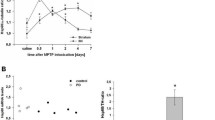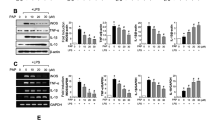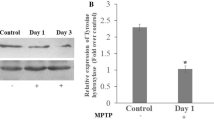Abstract
In Parkinson’s disease, dopaminergic neuron damage/death causes the release of soluble substances that are selectively toxic to neighboring/additional dopaminergic neurons through the activation of microglia. Hsp60 can be released from injured cells of central nervous system to activate microglia. However, its expression and role in Parkinson’s disease has not been well understood. Here, we performed a 6-OHDA treated Parkinson’s disease model in adult rats. Western blot analysis showed a time-course expression of Hsp60, which decreased gradually and then rose back. Immunofluorescence staining showed that Hsp60 was decreased in dopaminergic neuron, and most Hsp60 located on the surface of activated microglia. Furthermore, in cellular Parkinson’s disease model, Hsp60 was obviously detected in the culture supernatants after 6-OHDA treatment, and a concomitant decrease in cell extracts. Taken together, our results suggested that Hsp60 could be released extracellularly to activate microglia in Parkinson’s disease model.






Similar content being viewed by others
Abbreviations
- Hsp60:
-
Heat shock protein 60
- 6-OHDA:
-
6-Hydroxydopamine
- PD:
-
Parkinson’s disease
- CNS:
-
Central nervous system
- SNpc:
-
Substantia nigra pars compacta
- TLR-4:
-
Toll like receptor-4
- NF-κB:
-
Nuclear factor kappa B
- IKK:
-
I-κB kinase
References
Auluck PK, Chan HY, Trojanowski JQ, Lee VM, Bonini NM (2002) Chaperone suppression of alpha-synuclein toxicity in a Drosophila model for Parkinson’s disease. Science 295:865–868
Tufekci KU, Meuwissen R, Genc S, Genc K (2012) Inflammation in Parkinson’s disease. Adv Protein Chem Struct Biol 88:69–132
Marinova-Mutafchieva L, Sadeghian M, Broom L, Davis JB, Medhurst AD, Dexter DT (2009) Relationship between microglial activation and dopaminergic neuronal loss in the substantia nigra: a time course study in a 6-hydroxydopamine model of Parkinson’s disease. J Neurochem 110:966–975
Liu J, Wang MW, Gu P, Ma QY, Wang YY, Geng Y, Yuan ZY, Cui DS, Zhang ZX, Ma L, Zhang BH, Zhou MG, Zhu AP (2010) Microglial activation and age-related dopaminergic neurodegeneration in MPTP-treated SAMP8 mice. Brain Res 1345:213–220
Block ML, Hong JS (2007) Chronic microglial activation and progressive dopaminergic neurotoxicity. Biochem Soc Trans 35:1127–1132
Teismann P, Schulz JB (2004) Cellular pathology of Parkinson’s disease: astrocytes, microglia and inflammation. Cell Tissue Res 318:149–161
Zhang F, Qian L, Flood PM, Shi JS, Hong JS, Gao HM (2010) Inhibition of IkappaB kinase-beta protects dopamine neurons against lipopolysaccharide-induced neurotoxicity. J Pharmacol Exp Ther 333:822–833
Soltys BJ, Gupta RS (2000) Mitochondrial proteins at unexpected cellular locations: export of proteins from mitochondria from an evolutionary perspective. Int Rev Cytol 194:133–196
Lin L, Kim SC, Wang Y, Gupta S, Davis B, Simon SI, Torre-Amione G, Knowlton AA (2007) HSP60 in heart failure: abnormal distribution and role in cardiac myocyte apoptosis. Am J Physiol Heart Circ Physiol 293:H2238–H2247
Beckmann RP, Lovett M, Welch WJ (1992) Examining the function and regulation of hsp 70 in cells subjected to metabolic stress. J Cell Biol 117:1137–1150
Gething MJ, Sambrook J (1992) Protein folding in the cell. Nature 355:33–45
Itoh H, Kobayashi R, Wakui H, Komatsuda A, Ohtani H, Miura AB, Otaka M, Masamune O, Andoh H, Koyama K, Yasuhiko S, Yohtalou T (1995) Mammalian 60-kDa stress protein (chaperonin homolog). Identification, biochemical properties, and localization. J Biol Chem 270:13429–13435
Xanthoudakis S, Roy S, Rasper D, Hennessey T, Aubin Y, Cassady R, Tawa P, Ruel R, Rosen A, Nicholson DW (1999) Hsp60 accelerates the maturation of pro-caspase-3 by upstream activator proteases during apoptosis. EMBO J 18:2049–2056
Knowlton AA, Gupta S (2003) HSP60, Bax, and cardiac apoptosis. Cardiovasc Toxicol 3:263–268
Kirchhoff SR, Gupta S, Knowlton AA (2002) Cytosolic heat shock protein 60, apoptosis, and myocardial injury. Circulation 105:2899–2904
Chun JN, Choi B, Lee KW, Lee DJ, Kang DH, Lee JY, Song IS, Kim HI, Lee SH, Kim HS, Lee NK, Lee SY, Lee KJ, Kim J, Kang SW (2010) Cytosolic Hsp60 is involved in the NF-kappaB-dependent survival of cancer cells via IKK regulation. PLoS ONE 5:e9422
Gupta S, Knowlton AA (2002) Cytosolic heat shock protein 60, hypoxia, and apoptosis. Circulation 106:2727–2733
Osterloh A, Geisinger F, Piedavent M, Fleischer B, Brattig N, Breloer M (2009) Heat shock protein 60 (HSP60) stimulates neutrophil effector functions. J Leukoc Biol 86:423–434
Tsan MF, Gao B (2004) Heat shock protein and innate immunity. Cell Mol Immunol 1:274–279
Woods DC, White YA, Dau C, Johnson AL (2011) TLR4 activates NF-kappaB in human ovarian granulosa tumor cells. Biochem Biophys Res Commun 409:675–680
Goh YC, Yap CT, Huang BH, Cronshaw AD, Leung BP, Lai PB, Hart SP, Dransfield I, Ross JA (2010) Heat-shock protein 60 translocates to the surface of apoptotic cells and differentiated megakaryocytes and stimulates phagocytosis. Cell Mol Life Sci 68:1581–1592
Lehnardt S, Schott E, Trimbuch T, Laubisch D, Krueger C, Wulczyn G, Nitsch R, Weber JR (2008) A vicious cycle involving release of heat shock protein 60 from injured cells and activation of toll-like receptor 4 mediates neurodegeneration in the CNS. J Neurosci 28:2320–2331
Liu Y, Wang Y, Cheng C, Chen Y, Shi S, Qin J, Xiao F, Zhou D, Lu M, Lu Q, Shen A (2010) A relationship between p27(kip1) and Skp2 after adult brain injury: implications for glial proliferation. J Neurotrauma 27:361–371
Carta M, Carlsson T, Kirik D, Bjorklund A (2007) Dopamine released from 5-HT terminals is the cause of L-DOPA-induced dyskinesia in parkinsonian rats. Brain 130:1819–1833
Liu Y, Chen Y, Lu X, Wang Y, Duan Y, Cheng C, Shen A (2012) SCYL1BP1 modulates neurite outgrowth and regeneration by regulating the Mdm2/p53 pathway. Mol Biol Cell 23:4506–4514
Wachter B, Schurger S, Rolinger J, von Ameln-Mayerhofer A, Berg D, Wagner HJ, Kueppers E (2010) Effect of 6-hydroxydopamine (6-OHDA) on proliferation of glial cells in the rat cortex and striatum: evidence for de-differentiation of resident astrocytes. Cell Tissue Res 342:147–160
Soltys BJ, Gupta RS (1996) Immunoelectron microscopic localization of the 60-kDa heat shock chaperonin protein (Hsp60) in mammalian cells. Exp Cell Res 222:16–27
Hansen JJ, Dürr A, Cournu-Rebeix I, Georgopoulos C, Ang D, Nielsen MN, Davoine CS, Brice A, Fontaine B, Gregersen N, Bross P (2002) Hereditary spastic paraplegia SPG13 is associated with a mutation in the gene encoding the mitochondrial chaperonin Hsp60. Am J Hum Genet 70:1328–1332
Hansen J, Svenstrup K, Ang D, Nielsen MN, Christensen JH, Gregersen N, Nielsen JE, Georgopoulos C, Bross P (2007) A novel mutation in the HSPD1 gene in a patient with hereditary spastic paraplegia. J Neurol 254:897–900
Magen D, Georgopoulos C, Bross P, Ang D, Segev Y, Goldsher D, Nemirovski A, Shahar E, Ravid S, Luder A, Heno B, Gershoni-Baruch R, Skorecki K, Mandel H (2008) Mitochondrial hsp60 chaperonopathy causes an autosomal-recessive neurodegenerative disorder linked to brain hypomyelination and leukodystrophy. Am J Hum Genet 83:30–42
Wallin RP, Lundqvist A, More SH, von Bonin A, Kiessling R, Ljunggren HG (2002) Heat-shock proteins as activators of the innate immune system. Trends Immunol 23:130–135
Tsan MF, Gao B (2004) Cytokine function of heat shock proteins. Am J Physiol Cell Physiol 286:C739–C744
Gupte AA, Morris JK, Zhang H, Bomhoff GL, Geiger PC, Stanford JA (2010) Age-related changes in HSP25 expression in basal ganglia and cortex of F344/BN rats. Neurosci Lett 472:90–93
Hwang IK, Ahn HC, Yoo KY, Lee JY, Suh HW, Kwon YG, Cho JH, Won MH (2007) Changes in immunoreactivity of HSP60 and its neuroprotective effects in the gerbil hippocampal CA1 region induced by transient ischemia. Exp Neurol 208:247–256
Sawada M, Imamura K, Nagatsu T (2006) Role of cytokines in inflammatory process in Parkinson’s disease. J Neural Transm Suppl 70:373–381
Chen H, Zhang SM, Hernan MA, Schwarzschild MA, Willett WC, Colditz GA, Speizer FE, Ascherio A (2003) Nonsteroidal anti-inflammatory drugs and the risk of Parkinson disease. Arch Neurol 60:1059–1064
Chen H, Jacobs E, Schwarzschild MA, McCullough ML, Calle EE, Thun MJ, Ascherio A (2005) Nonsteroidal antiinflammatory drug use and the risk for Parkinson’s disease. Ann Neurol 58:963–967
Chen H, O’Reilly EJ, Schwarzschild MA, Ascherio A (2008) Peripheral inflammatory biomarkers and risk of Parkinson’s disease. Am J Epidemiol 167:90–95
Huh Y, Jung J, Park C, Ryu J, Shin C, Kim W, Ryu J (2003) Microglial activation and tyrosine hydroxylase immunoreactivity in the substantia nigral region following transient focal ischemia in rats. Neurosci Lett 349:63–67
McGeer PL, Schwab C, Parent A, Doudet D (2003) Presence of reactive microglia in monkey substantia nigra years after 1-methyl-4-phenyl-1,2,3,6-tetrahydropyridine administration. Ann Neurol 54:599–604
Yokoyama H, Uchida H, Kuroiwa H, Kasahara J, Araki T (2011) Role of glial cells in neurotoxin-induced animal models of Parkinson’s disease. Neurol Sci 32:1–7
Levesque S, Wilson B, Gregoria V, Thorpe LB, Dallas S, Polikov VS, Hong JS, Block ML (2010) Reactive microgliosis: extracellular micro-calpain and microglia-mediated dopaminergic neurotoxicity. Brain 133:808–821
Kim YS, Kim SS, Cho JJ, Cho JJ, Choi DH, Hwang O, Shin DH, Chun HS, Beal MF, Joh TH (2005) Matrix metalloproteinase-3: a novel signaling proteinase from apoptotic neuronal cells that activates microglia. J Neurosci 25:3701–3711
Farber K, Cheung G, Mitchell D, Wallis R, Weihe E, Schwaeble W, Kettenmann H (2009) C1q, the recognition subcomponent of the classical pathway of complement, drives microglial activation. J Neurosci Res 87:644–652
Vabulas RM, Ahmad-Nejad P, da Costa C, Miethke T, Kirschning CJ, Hacker H, Wagner H (2001) Endocytosed HSP60s use toll-like receptor 2 (TLR2) and TLR4 to activate the toll/interleukin-1 receptor signaling pathway in innate immune cells. J Biol Chem 276:31332–31339
Bulut Y, Faure E, Thomas L, Karahashi H, Michelsen KS, Equils O, Morrison SG, Morrison RP, Arditi M (2002) Chlamydial heat shock protein 60 activates macrophages and endothelial cells through Toll-like receptor 4 and MD2 in a MyD88-dependent pathway. J Immunol 168:1435–1440
Acknowledgments
This work was supported by Natural Science Foundation of Jiangsu province (No. BK2008480) and ‘‘Six Talent Peak’’ Foundation of Jiangsu province (2010-WS-030).
Author information
Authors and Affiliations
Corresponding authors
Additional information
Mei jiang Feng and Ling Zhang contributed equally to this work.
Electronic supplementary material
Below is the link to the electronic supplementary material.
11064_2013_1127_MOESM1_ESM.tif
TH immunoreactivity in the whole SN at sham control (a), 6-OHDA 1 week (b), and 6-OHDA 4 week (c) by immunohistochemistry. There was a progressive loss of dopaminergic neurons in the SN of rats injected with 6-OHDA. Scale bar 50μm (TIFF 2129 kb)
11064_2013_1127_MOESM2_ESM.tif
Quantitative analysis of CD11b positive cells expressing Hsp60 (%) in control group, 1, 2 and 4 week after 6-OHDA injection. *P < 0.05 as compared with the control group. Error bars represent SEM (TIFF 631 kb)
Rights and permissions
About this article
Cite this article
Feng, M.j., Zhang, L., Liu, Z. et al. The Expression and Release of Hsp60 in 6-OHDA Induced In Vivo and In Vitro Models of Parkinson’s Disease. Neurochem Res 38, 2180–2189 (2013). https://doi.org/10.1007/s11064-013-1127-8
Received:
Revised:
Accepted:
Published:
Issue Date:
DOI: https://doi.org/10.1007/s11064-013-1127-8




